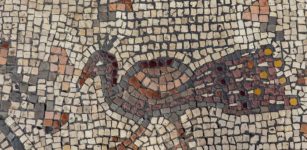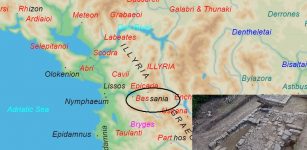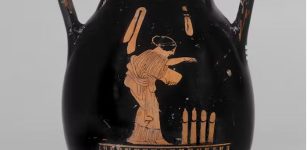Elusive Planet Mercury As Seen Through The Eyes Of Ancient Astronomers
Ellen Lloyd - AncientPages.com - In ancient times the elusive planet Mercury was known under a variety of different names such as Nabu, Thoth, Hermes, Apollo, Buddha and more.
Mercury is the closest planet to the Sun. This hot planet that can reach 840 degrees Fahrenheit (450 degrees Celsius) and it was studied by many ancient astronomers who observed it regulary. It is believed that Mercury was known since at least Sumerian times roughly 5,000 years ago, where it was often associated with Nabu, the god of writing.
Sumerians and Babylonians named Mercury after the god of writing - Nabu
The inhabitants of Mesopotamia from about 3500 B.C. to about 2000 B.C. are referred to as Sumerians.
This civilization developed a written language using signs for words and syllables; their writing is preserved on clay tablets. They are thought to have studied the movements of the Sun, the Moon and the visible planets, although no written records of such observations from this early period remain. In this, as in many other early cultures, the motions of celestial objects were
of great interest because of their religious significance, and particularly because they were thought to give clues about the future course of human events. We now call this belief astrology and distinguish it from astronomy, the scientific study of the heavens.
The Sumerians named the Sun, the Moon and the visible planets - including Mercury - after their greatest seven gods. Translations from surviving cuneiform tablets reveal that Mercury was designated by many names, including that transcribed by archaeologists as MulUDU.IDIM.GU.UD. Mercury was often associated with Nabu, or Ninurta, the god of water and writing. Later, in Akkadian, it became known as Shikhtu, meaning “jumpy”.
The Sumerian civilization was succeeded by the Babylonians, a culture that inherited writing, astronomy, and mathematics from the Sumerians. Early Babylonian astronomers (2000 – 1000 B.C.) may have recorded their observations of the sky: Although no records from that period have survived, tablets from the 7th century B.C. refer to observations of Venus supposedly made much earlier, during the reign of King Ammisaduqa (1702 – 1682 B.C.).
We also know that from 800 B.C. onward the Babylonians cataloged stars, kept records of records of solar eclipses and the time intervals between new moons, and were able to predict some astronomical phenomena.
The Babylonians named Mercury after their divinity Nebo or Nabu, - the record keeper, god of writing, and messenger to the gods. As Mount Sinai in Egypt is named for the Babylonian moon god Sin, Mount Nebo, in present-day Jordan, is named after the Babylonian god of the planet Mercury. In Babylonian astronomy Mercury was associated with both sexes because of its appearance as both an evening and a morning star.
Later Babylonian civilizations (600 B.C. – 200 AD) were yet more advanced in mathematics and astronomy. Their catalog of the stars forms the basis of our zodiac. They also made detailed observations of the movements of the five visible planets, including Mercury.
Mercury was called “Buddha” in ancient India
Astronomers in ancient India believed that the location of the planets in the sky at the time of birth determined a person’s future. The Hindus called the planets collectively “navagrahs” and references to them can be found on temple markings.
As in other early cultures, the planets were given the names of divinities; Mercury was called Budha.
Ancient Chinese called Mercury Chen Xing
In ancient China, Mercury was known as Chen Xing, the Hour Star. It was associated with the direction north and the phase of water in the Wu Xing. Modern Chinese, Korean, Japanese and Vietnamese cultures refer to the planet literally as the "water star", based on the Five elements.
Ancient Egyptians called Mercury - Thoth, the great measurer
Ancient Egyptians were fascinated with the study of the night sky, planets, stars and other celestial bodies.
In ancient Greece Mercury was known under two different names – Apollo and Hermes
Early Greek civilization, from 1400 to 200 BC, made many contributions to astronomy. Unlike other early astronomers who were astrologers as well, Greek astronomers were often considered philosophers and mathematicians, as we know from the works of those such as Plato and Eudoxus.
Around 450 B.C. the Greeks started studying the motions of the planets and using geometry to measure the size of the Earth, Sun and Moon.
See also:
Astronomically Aligned Temples And Pyramids Of Ancient World
Sunduki – “Home Of The Gods” – One Of The World’s Oldest Astronomical Observatories
Mercury was known by two different names, associated with its evening and morning appearances. These were Apollo (god of truth, the arts, archery, plagues, and divination) and Hermes (god of writing and messenger to the other gods). Plato and Eudoxus reported that the synodic and sidereal periods of Mercury were 110 days and 1 year respectively. Later Greek astronomers made detailed star charts and determined planetary motions, often building on earlier work. In 200 AD the Greek astronomer Ptolemy completed his Almagest, a comprehensive text of mathematical astronomy. Translated into Latin around 1400 AD, Ptolemy’s work was considered by Europeans to be the authority on astronomical understanding until the early 1600’s. Ptolemy’s model of the solar system was geocentric, or Earth-centered.
The Sun and planets were thought to travel around the Earth from east to west, with the planets moving on more complicated cyclic paths about their average positions.
The Mayas believed Mercury was just as important as the Sun
Mayan astronomers were primarily interested in the “Zenial Passages” – times when the Sun crossed over certain Mayan latitudes. Mayan astronomy is thought to have developed in the period from 1500 BC to 800 BC. Much of what we know of it is found in writing known as the Dresden Codex, a band of paper 3.5 meters long arranged in 39 sheets. This contains information regarding the calendar system, astronomical data and sky mechanics, as well as tables of multiple integers thought to have been used in the calculations of planetary movements.
The Mayas were also deeply interested in the planet Venus, believing it to be as important as the Sun. But the Mayas charted the motion of the planet Mercury as well; records of their detailed observations are found in the Dresden Codex.
These include the appearance of Mercury as a morning star in 733 B.C. and as an evening star in 727. The Mayans also calculated that Mercury would rise and set in the same place in the sky every 2,200 days.
Written by - Ellen Lloyd – AncientPages.com
Copyright © AncientPages.com All rights reserved. This material may not be published, broadcast, rewritten or redistributed in whole or part without the express written permission of AncientPages.com
Expand for referencesMore From Ancient Pages
-
 Chilean Mummies Clad In Red Poison Dresses – Evidence Of A Unique Inca Ritual
Archaeology | Jul 28, 2018
Chilean Mummies Clad In Red Poison Dresses – Evidence Of A Unique Inca Ritual
Archaeology | Jul 28, 2018 -
 Isabel Neville And Unsolved Mystery Of Her Death
Featured Stories | Mar 28, 2019
Isabel Neville And Unsolved Mystery Of Her Death
Featured Stories | Mar 28, 2019 -
 10,000 Years Ago Cattle Was Domesticated In The Central Nile Region – New Study
Archaeology | May 23, 2022
10,000 Years Ago Cattle Was Domesticated In The Central Nile Region – New Study
Archaeology | May 23, 2022 -
 Ancient Civilizations Invented Alcohol 10,000 Years Ago
Ancient History Facts | Sep 13, 2016
Ancient Civilizations Invented Alcohol 10,000 Years Ago
Ancient History Facts | Sep 13, 2016 -
 Överhogdal Tapestry: Amazingly Well-Preserved Ancient Textiles With Norse And Christian Motifs
Artifacts | Apr 26, 2019
Överhogdal Tapestry: Amazingly Well-Preserved Ancient Textiles With Norse And Christian Motifs
Artifacts | Apr 26, 2019 -
 Gigantic Bird Ziz Is One Of Participants At Messianic Banquet At The End Of Days In Jewish Folklore
Featured Stories | May 8, 2020
Gigantic Bird Ziz Is One Of Participants At Messianic Banquet At The End Of Days In Jewish Folklore
Featured Stories | May 8, 2020 -
 Biblical Mosaic Depicting Miracles Of Jesus Discovered At The ‘Burnt Church’ In Hippos
Archaeology | Sep 24, 2019
Biblical Mosaic Depicting Miracles Of Jesus Discovered At The ‘Burnt Church’ In Hippos
Archaeology | Sep 24, 2019 -
 On This Day In History: Chaldean Account Of The Deluge Translated And Presented For The First Time – On Dec 3, 1872
News | Dec 3, 2016
On This Day In History: Chaldean Account Of The Deluge Translated And Presented For The First Time – On Dec 3, 1872
News | Dec 3, 2016 -
 2,000-Year-Old Lost Illyrian City Unearthed In Albania By Polish Archaeologists
Archaeology | Jun 13, 2018
2,000-Year-Old Lost Illyrian City Unearthed In Albania By Polish Archaeologists
Archaeology | Jun 13, 2018 -
 Deciphered Ancient Stone Tablets Contain Sacred Knowledge That Could Re-Write History
Ancient Mysteries | Aug 28, 2018
Deciphered Ancient Stone Tablets Contain Sacred Knowledge That Could Re-Write History
Ancient Mysteries | Aug 28, 2018 -
 How Large Was The ‘Giant’ Dunkleosteus Terrelli – Prehistoric King Of The Oceans?
News | Apr 10, 2023
How Large Was The ‘Giant’ Dunkleosteus Terrelli – Prehistoric King Of The Oceans?
News | Apr 10, 2023 -
 On This Day In History: Brazil Was Officially Discovered – On Jan 26, 1500
News | Jan 26, 2017
On This Day In History: Brazil Was Officially Discovered – On Jan 26, 1500
News | Jan 26, 2017 -
 Ceramics Are Telling The Story Of 14th Century Chinese Trade
News | Jun 28, 2023
Ceramics Are Telling The Story Of 14th Century Chinese Trade
News | Jun 28, 2023 -
 Mayan Maize God And Ancient City Of El Mirador
Featured Stories | Apr 25, 2019
Mayan Maize God And Ancient City Of El Mirador
Featured Stories | Apr 25, 2019 -
 Massive Menhir Champ Dolent Built By Fairies In Ancient Beliefs Of Brittany’s People
Featured Stories | Jan 13, 2025
Massive Menhir Champ Dolent Built By Fairies In Ancient Beliefs Of Brittany’s People
Featured Stories | Jan 13, 2025 -
 Iron Age Site Of Khok Phutsa Excavated In Thailand
Archaeology | Apr 15, 2019
Iron Age Site Of Khok Phutsa Excavated In Thailand
Archaeology | Apr 15, 2019 -
 Mysterious 2,800-Year-Old Channel Installation Discovered In The City Of David, Jerusalem
Archaeology | Aug 30, 2023
Mysterious 2,800-Year-Old Channel Installation Discovered In The City Of David, Jerusalem
Archaeology | Aug 30, 2023 -
 Centeotl: Lord Of Maize Who Was Revered Before The Olmecs By All Mesoamerica’s Inhabitants
Featured Stories | Feb 20, 2024
Centeotl: Lord Of Maize Who Was Revered Before The Olmecs By All Mesoamerica’s Inhabitants
Featured Stories | Feb 20, 2024 -
 The Long And Satisfying 28,000-Year History Of The Dildo
Featured Stories | Feb 27, 2023
The Long And Satisfying 28,000-Year History Of The Dildo
Featured Stories | Feb 27, 2023 -
 Mystery Of The Brave Viking Chief Buried On The Gokstad Ship
Featured Stories | Mar 14, 2016
Mystery Of The Brave Viking Chief Buried On The Gokstad Ship
Featured Stories | Mar 14, 2016



